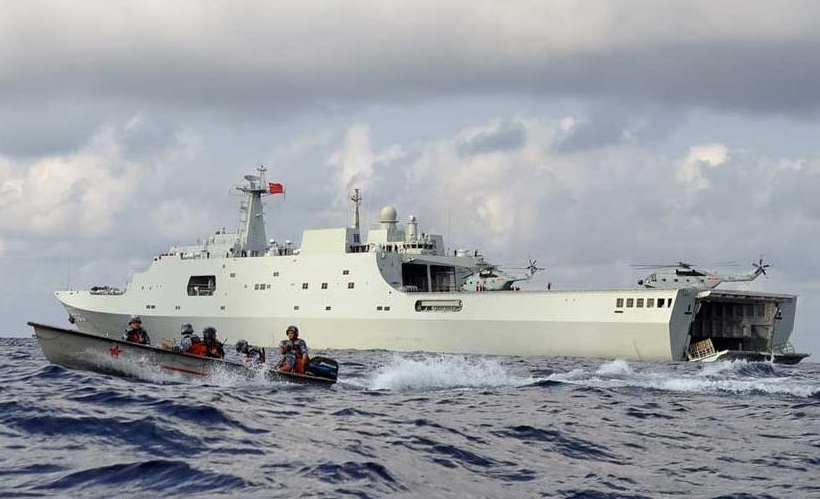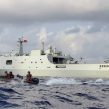
South Sea Fleet Exercises Shine Spotlight on Tensions
Publication: China Brief Volume: 13 Issue: 7
By:

Tensions in the South China Sea once again appear to be on the rise as recent Chinese naval activity has attracted the attention of regional actors. On March 26, Hanoi publicly complained that a People’s Liberation Army (PLA) Navy vessel had set a Vietnamese fishing vessel on fire. Beijing denied the accusation, countering that the PLA Navy (PLAN) ship had fired two signal flares as a warning near a Vietnamese fishing vessel that was operating illegally in Chinese territorial waters (Xinhua, March 27; People’s Daily Online, March 26). At the same time, the PLAN’s South Sea Fleet—one of the three major naval commands—has conducted a series of exercises that assert Chinese sovereignty and fulfills the “preparations for actual combat” requirements that President Xi Jinping has called for in military training (Xinhua, March 19; PLA Daily, January 13; December 12, 2012).
This month, the South Sea Fleet exercised its amphibious, naval and aviation assets to prepare for the range of conceivable South China Sea conflict scenarios. The latest training exercise involves a four-ship flotilla including the PLAN’s most advanced amphibious assault ship, a guided-missile destroyer and two guided-missile frigates (China Military Online, March 20). The flotilla has conducted a range of exercises, including amphibious and airborne assault on an atoll as well as a combined arms exercise involving the ships and shore-based early warning aircraft, fighter and fighter-bombers (PLA Daily, March 25; China Military Online, March 25; People’s Daily Online, March 22). This follows other exercises earlier in March when a South Sea Fleet fighter regiment flying the Su-30MKK2 fighter-bomber conducted strike training over the South China Sea. Other local PLAN Air Force elements also conducted flight training exercises with now-standard emphasis on “actual combat” preparation (People’s Daily Online, March 5; March 4).
Once again, Beijing’s efforts to reassure neighboring countries that this level of activity is only routine and lacking ulterior motives seem to be falling on deaf ears (“Soothing Tones on China’s Rise Strike Dissonance,” China Brief, January 4). In an effort to explain the exercises, Xinhua noted the training is a “regular arrangement in line with the navy’s annual training plan,” adding that the PLAN conducted seven similar training exercises last year (Xinhua, March 19). Elsewhere, Chinese naval experts add that exercises accord “with all international laws and common practice,” highlighting that South Sea Fleet exercises are unexceptional compared to other international navies (Xinhua, March 25). The path of the flotilla, however, has taken it close to disputed territory where Malaysia maintains offshore oil rigs and, en route to the Western Pacific, the four PLAN ships will skirt the Philippines’ western maritime boundaries. The exercise itself may be only routine and in line with a responsible military’s training for the possible contingencies it might face. These training missions, however, have the side effect of demonstrating China’s ability to deliver military power, including amphibious troops, across its entire claim in the South China Sea—as Xinhua rather ostentatiously announced when the flotilla reached southernmost claim (Xinhua, March 26).
More importantly, Chinese reassurances about the South Sea Fleet’s exercises also highlight a contradiction in how Beijing applies the principle of freedom of navigation to its own and foreign military behavior. Official press stated the training exercises are “routine military training which is in conformity with international laws and international common practice.” Accordingly, the PLAN ships should be allowed freedom to navigate international waters without harassment, regardless of whether some of those waters may qualify as disputed or as another country’s exclusive economic zone (Xinhua, March 25). The drills however are to be conducted in line with “the requirements of actual combat,” making these maneuvers a military mission (Xinhua, March 19). One of the reasons Beijing has rejected U.S. calls for freedom of navigation in China’s maritime periphery and the South China Sea is that Beijing believes the principle is different for civilian and military vessels, especially if the latter have a military mission. Chinese harassment of the USNS Impeccable was justified in exactly this way, because Beijing rejected U.S. protestations that a military-owned vessel could operate with peaceful intentions (Guangzhou Daily, July 17, 2012; Xinhua, July 11, 2012; Xinhua, March 10–11, 2009).
The overall direction of Chinese military modernization supports Beijing’s protestations of innocence that it has any ulterior motive in these exercises. In addition to wanting to achieve major progress on military modernization by 2020, Chinese leaders increasingly have discussed the idea of China becoming a “maritime power” over the last two years—most notably at the National People’s Congress meeting two years ago (“Military Delegates Call for National Maritime Strategy to Protect Expanding Interests,” China Brief, March 10, 2011). In most respects, the recent South Sea Fleet training exercises are normal and in line with stated Chinese intentions.
The atmospherics surrounding these exercises, however, suggest Beijing is using routine activities to frame the status quo in the South China Sea in its favor. Publicizing PLAN sailors’ pledge to safeguard Chinese sovereignty through national-level propaganda organs was unnecessary, reinforcing the idea Beijing maintains its firm, non-negotiable stance on China’s maritime boundaries. The quantity and quality of the PLAN equipment, including some of its most advanced aircraft and ships, already ensured special attention would be paid without alarming statements about how the PLAN exercised at the furthest reach of Chinese territory (Xinhua, March 26; South China Morning Post, March 26). As normal as the exercises might seem, even the usually quiet Malaysians have expressed concern about the path of a PLAN flotilla conducting drills at the south end of the South China Sea (Wall Street Journal, March 27). The explicit contradictions between China’s statements, actions and principles, thus, are lowering regional expectations that the country’s “peaceful development” is anything other than convenient rhetoric.





